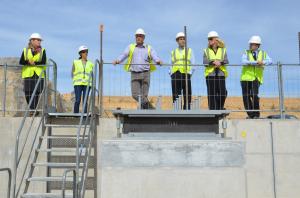Assessing ITER progress for the US legislators
1 Oct 2012
"We never quite realized until today the sheer size of the project and the state of development it has reached already," said the visitors from the US Senate and House of Representatives. They are seen here at the Tokamak Seismic Pit with ITER's Tim Watson and Caroline Forestier, who works for the European site team.
Through their respective Appropriations Committees, the United States Senate and House of Representatives oversee the billions of federal dollars allocated to different projects.
While projects are closely monitored by way of regular reports and meetings, it is important for the US legislators to get a concrete experience of their reality. This is even more necessary when a project is located outside the US and is part of a larger international collaboration, like ITER.
Senators and Congresspeople, however, are very busy and often rely on close aides to "see on the ground" the projects they have to assess.
Three of these congressional and senatorial aides, plus a press secretary in the House of Representatives, visited ITER last week, met with Director-General Osamu Motojima and ITER Organization senior management, and were given an extensive tour of the work site. They were all highly impressed by what they saw.
"When we deal with our participation in the ITER Project," explained one of the visitors, "we naturally focus on the components that are procured by the US Domestic Agency, so we never quite realized until today the sheer size of the project, and the state of development it has reached already. Also, it was important for us to see beyond the US contribution to the project and take full measure of the international dimension of ITER."


